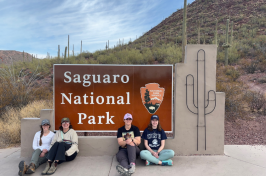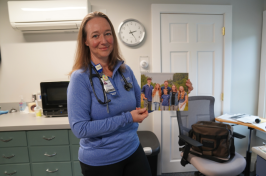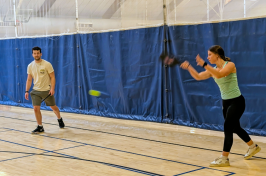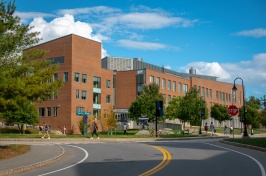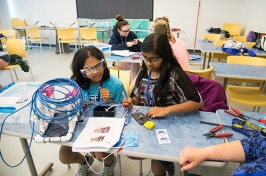
In the crowded atrium of Morse Hall, large posters mounted on easels described cutting-edge science ranging from genetically engineered plants to 3-D bio-printing to an ultra-low frequency magnetometer.
But this was no ordinary gathering of scientists. The poster authors were teenagers participating in Project SMART (Science and Mathematics Achievement Through Research Training), a UNH summer institute that gives rising high school juniors and seniors the chance to study biotechnology or space science and get a close-up look at the research process alongside UNH faculty. The July 26 poster session, part of the closing ceremony on the program’s final day, enabled the participants to showcase what they had learned during four intense weeks. Dozens of relatives, friends and UNH administrators got an overview of projects that explored scientific technologies and their impacts on society.
|
Project SMART is one of several summer programs at UNH that give young people an opportunity to explore science, technology, engineering and math. Others include: Engineeristas: a one-week camp that exposes middle-school girls to a wide range of engineering disciplines, including environmental, oceanographic and marine, computer science, and mechanical and materials. Tech Camp: a two-week camp that allows students (grades 7-10) to explore several engineering fields as well as robotics and computer technology. Keepers (Kids Eager for Engineering Programs with Elementary Research-based Science): a one-week camp (with three sessions) that introduces elementary school students to various engineering disciplines through hands-on activities. UNH IOL (InterOperability Laboratory) High School Summer Internship: a seven-week program that lets academically talented high school students gain real-world experience working in a global networking company. |
Caroline Gettens, who attends St. Paul’s Academy in Concord, studied so-called gene doping, in which athletes use genes to enhance their athletic performance.
“I thought it was very interesting because it’s a new form of doping in the Olympics,” she explained. “There are a lot of ethical and moral issues associated with it.” For instance, critics contend that it amounts to playing god, though proponents argue that it allows people of differing natural abilities to compete on a level playing field.
Gettens also learned more about her own scientific interests this summer. Before the program, she had wanted to be a surgeon; now, after taking part in in-depth labs and visiting New England BioLabs Inc. in Ipswich, Mass., she’s considering some form of biotechnology.
“I’m interested in cancer and the developments for curing cancer,” said Gettens, who has seen relatives struggle with the disease. “It was really nice to have people who are actually in the field of cancer research come talk to us.”
As Gettens honed her pipetting skills, Eloy Torres of Hayward, Calif., learned the programming language IDL in order to look for extremely low-frequency events in data sets produced by a magnetometer, which measures the magnitude of magnetic fields. Torres, who attends a small charter school, discovered that the research process isn’t always smooth. For instance, as the only Mac user in his group, he had to download special programs in order to build a micro-computer. “After five tries, I finally got the LED light to flash. That felt good.”
|
|
Others chose projects to which they had a personal connection. According to Carla Cerda, who attends Eagle Rock High School in Los Angeles, researchers have found that identical twins, who share the same genes, get less and less identical as they grow older. That’s because their increasingly dissimilar environments result in different patterns of gene expression.
“Identical twins were once thought to be exactly the same, but this research explains a lot about their personalities and the way their environment affects identity,” Cerda said.
Cerda was attending Project SMART with her sister Natalie — her identical twin. “Our personalities are very different,” Cerda explained, “and we don’t look exactly the same. People are able to tell us apart. So it’s interesting to see how that happened.”
Both Carla and Natalie Cerda, who studied artificial photosynthesis, said they especially valued the opportunity to gain lab experience at Project SMART — something they haven’t been able to do at their high school because of budget constraints.
“I took AP biology and many of the labs had to be cut out because we didn’t have enough materials,” Natalie Cerda said. “Now I feel more prepared for college labs.”
Their mother, Martha Cerda, said her daughters are even considering attending UNH.
“It’s the first time I’ve seen them in a month and to me they’re totally different people in terms of the science knowledge they’ve gained and their engagement in learning. It’s opened their eyes to different areas of science as well,” she said.
That’s part of the aim of Project Smart, which just completed its 22nd year. This summer, the 38 participants hailed from 12 states as well as Canada and Turkey. The students in the space science module flew high-altitude weather balloons, while the students in the biotechnology and nanotechnology module studied recent biological breakthroughs, including cloning, stem cells, genetic testing, gene therapy, and the genetic basis of cancer and aging. Outside the classroom, they visited the Boston Museum of Science and the New England Aquarium, enjoyed a whale-watching excursion, rode the cog railway to the top of Mt. Washington, and cruised the Piscataqua River.
In his farewell remarks to the group after the poster session, Project SMART director Subhash Minocha praised the students’ work and said the issues they had studied would be important to their lives. He also used science to inject some humor into the proceedings. Noting that some students had lamented that only four weeks remained before the start of school, he told them that one second contains one million micro-seconds.
“Think in terms of microseconds,” said the professor of plant biology and genetics, “and that four weeks sounds like a long time.”
Originally published by:
UNH Today
Written by Sonia Scherr ’13 MFA
Photography by Julie K. Byrd-Jenkins, UNH Photographic Services
-
Written By:
Staff writer | Communications and Public Affairs
























